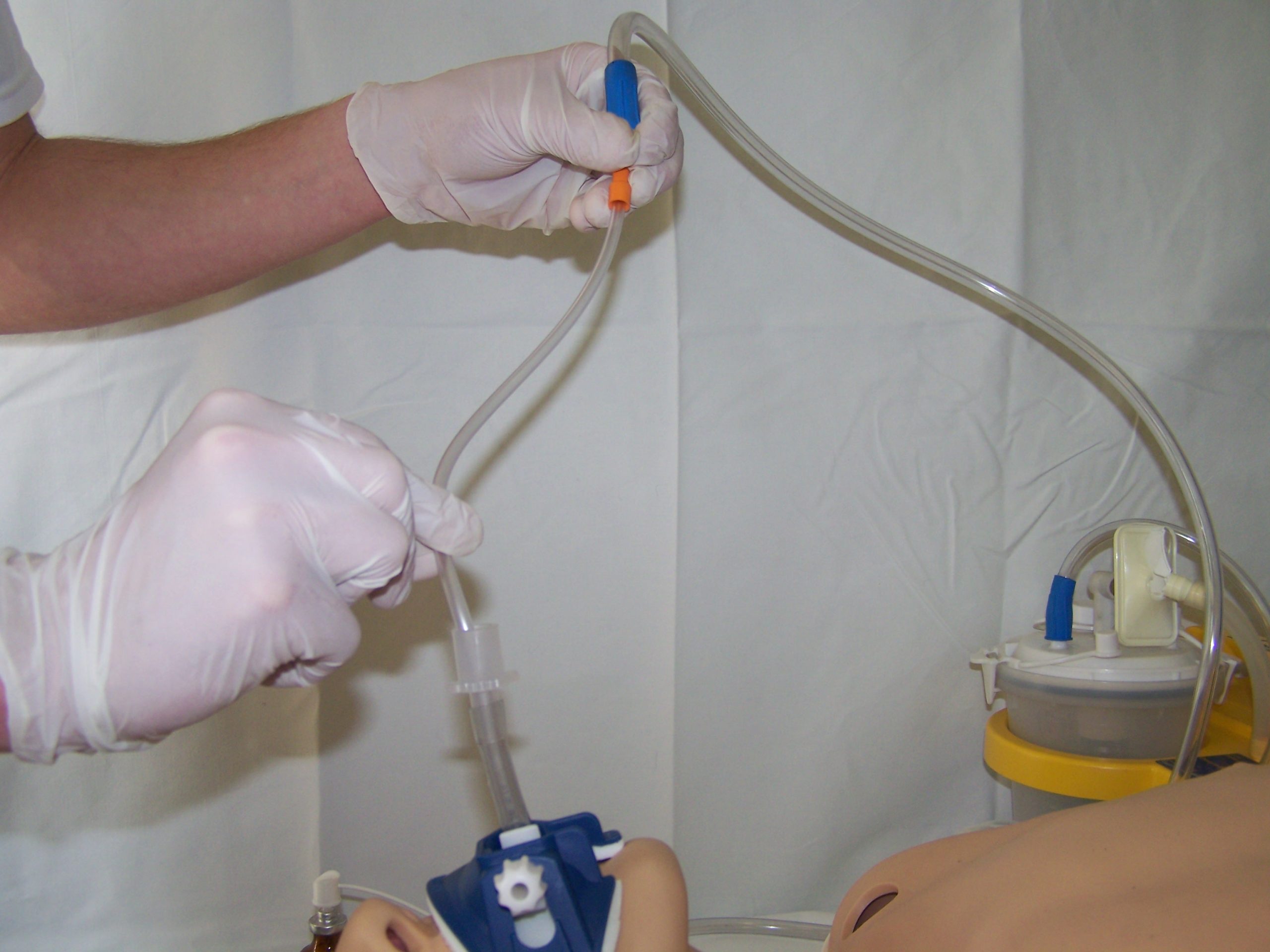In cases where inappropriate substances are present in the airways (e.g., vomit, blood, loose dental prostheses, excessive saliva due to hypersalivation, bronchial secretions), it is necessary to clean them through aspiration (Figure 7) or by using Magill’s forceps to prevent airway obstruction or the inhalation of contents deeper into the lungs, which can later lead to pneumonia as a result of aspiration.
The aspiration procedure begins when the catheter is positioned at the initial site in the airways (i.e., no aspiration occurs upon entry), and each pass should not last longer than 15 seconds in adults, 10 seconds in children, and 5 seconds in newborns. It is also necessary to have a flushing solution (e.g., an open plastic bottle of saline or plain water for upper airway aspiration) to clean the catheter in case of blockage. For oral cavity aspiration, we use hard plastic catheters with a wider diameter – Yankauer catheter, and for lower airway aspiration, we use soft, flexible catheters.
Aspiration and Cleaning of the Oral Cavity Equipment
- Personal protective equipment: protective gloves, protective mask, and goggles
- Aspirator with suction tubing and container
- Flushing solution (sterile saline or water)
- Hard plastic catheter – Yankauer (Figure 8)
- Magill’s forceps (Figure 9)
PROCEDURE
- Apply personal protective measures.
- Check the required equipment, with a focus on the functionality of the aspirator.
- Turn the patient or the patient’s head to the side if possible.
- Position yourself beside the patient’s head if possible.
- Open the patient’s mouth by pushing the lower jaw downward with your thumb.
- Use Magill’s forceps to remove larger items from the oral cavity.
- Place the aspiration catheter in the oral cavity, ensuring the concave side is directed towards the bottom of the oral cavity, with the catheter’s tip touching the base of the tongue.
- Do not introduce the catheter’s tip deeper than the base of the tongue; always maintain visual control.
- If there is a gag reflex, move the catheter slightly away from the base of the tongue or pull it out.
- Start suction only after positioning the catheter correctly and creating the necessary negative pressure for aspiration by closing the opening on the suction tubing with your finger.
- During aspiration, move the catheter from one side of the oral cavity to the other.
- Ensure that the procedure does not last longer than 15 seconds in one pass for adults.
- If the catheter becomes blocked, or after the aspiration procedure, rinse it immediately with flushing solution.
- If necessary, repeat the aspiration procedure, giving the patient time to rest in between and administering oxygen.
- Document all actions in the medical records.
IMPORTANT Always perform the aspiration with a hard catheter under visual control. If the aspirator has airflow but does not create negative pressure, check that all tubes and the container are correctly connected because even the smallest opening can render suction impossible.
Aspiration and Cleaning of Lower Airway Introduction The procedure for aspiration of the lower airway requires sterile conditions. To achieve this, sterile gloves are used to handle the aspiration catheter, and if the procedure needs to be repeated, a new sterile catheter is always used. Soft, flexible catheters can be used to aspirate through a pre-inserted oropharyngeal or nasopharyngeal tube, and aspiration through an endotracheal tube can also be performed when necessary. When aspirating through an endotracheal tube, it is advisable to measure the length of the suction catheter to ensure the tip does not pass beyond the end of the tube, which could potentially damage the bronchial mucosa.
Equipment
- Personal protective equipment: protective gloves, protective mask, and goggles
- Aspirator with suction tubing and container
- Flushing solution (sterile saline or water)
- Soft, flexible catheters of various sizes; use the widest possible diameter catheter (Figure 11)
- Magill’s forceps
IMPORTANT In case of suspected FOREIGN BODY in the lower part of the throat or the entrance to the larynx obstructing proper ventilation in UNCONSCIOUS PATIENTS, it is necessary to visualize the area with a laryngoscope (see Endotracheal Intubation) and remove the foreign body using Magill’s forceps and/or aspiration.
The aspiration procedure is an irreplaceable method for maintaining open and unobstructed airways; however, if performed with improper technique, it can lead to injury, swelling, spasm, hypoxia, and aspiration of content into the airways. Pay attention to the allowed duration of suction during a single pass.



0 Comments